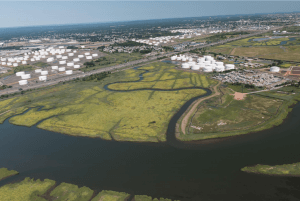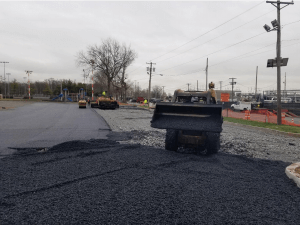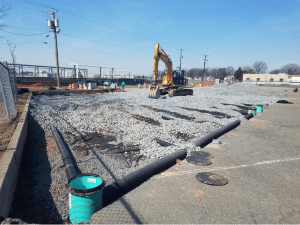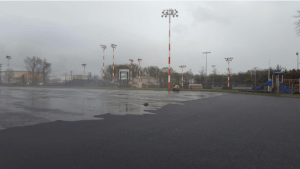
Linden, New Jersey’s Tremley Point region is surrounded by the Rahway River and Marshes Creek, putting the area at a high risk for flooding events. Photo ©Anthony Biancella.
By using Stormwater Green Infrastructure such as rain gardens and more recently porous parking lots, a CAIT-affiliated researcher is leading the way in building and implementing these environmentally-friendly measures to help control flooding events for at-risk neighborhoods.
Flooding is a constant concern for residents living in the approximately 275 homes located in Linden, NJ’s Tremley Point. A low-lying area bordered by the Rahway River and Marshes Creek, anything from storm surges to regular rainfall can put the area at risk.
Porous parking lots, which use an innovative type of pavement that has the ability to drain and then store water runoff, are part of the infrastructure solutions needed to protect this region and others like it, said Dr. George Guo, a professor in the Department of Civil and Environmental Engineering at the Rutgers School of Engineering (SoE) and a CAIT-affiliated researcher.
“If a neighborhood floods that usually means there was too much water rushing into the area for the drainage system to handle,” he said. “If you can reduce the volume of rain runoff, or slow it down, then you will have less water flowing into a neighborhood and give that water more time to drain—overall resulting in less flooding.”
This is how the two new porous parking lots built in the City of Linden work too. When rain or runoff hits the pavement it seeps through the pavement down to a layer of gravel, Dr. Guo explained. This acts as an underground reservoir before the water eventually is drained back out to the original catch basin. As a result, the innovative infrastructure helps address the rainfall source of flooding common to Tremley Point that may coincide with two other sources: ocean high tides and storm surges.

The larger of the two porous parking lots while being constructed in Linden, NJ in April 2019. Photo ©George Guo.
“Managing stormwater runoff is a huge challenge for many municipalities, due to pooling and potential flooding especially with municipalities near the waterfront,” said Derek Armstead, the mayor of Linden. “Building porous parking lots will help provide a solution to this problem, here in the Tremley Point area of Linden, and it will also allow water to flow under the surface eventually going back into the water table. We thank Rutgers School of Engineering for taking on this project at Marshes Creek and we thank the National Fish and Wildlife Foundation for the funding for this project.”
These parking lots stem from an over $2 million ongoing flood-mitigation and ecosystem-restoration project for Marshes Creek, awarded to Rutgers University and City of Linden by the National Fish and Wildlife Foundation (NFWF) and the U.S. Department of Interior (DOI) following Hurricane Sandy. The effort has resulted in the construction of rain gardens and other methods of flood mitigation in the area that work in unison with these latest developments.
“This project is a great example of how communities can use green stormwater infrastructure to decrease flood risks and improve resilience, while also improving water quality and wildlife habitat,” said Amanda Bassow, NFWF’s Northeastern Regional Director. “It is exciting to see Rutgers and Linden team up to get more of these innovative solutions on-the-ground that are wins for both people and wildlife.”

The same porous parking lot during another stage of construction. Photo ©George Guo.
Construction started in March 2019 and recently finished in April. The first, a 1-acre lot, is located next to a local baseball field. Construction crews transformed the area to make one-third of the lot porous. The lower end was made porous while the rest was left unchanged, so that as runoff rushes in it will move toward the porous section and be drained.
“We had the first rain a few days after finishing construction on this project,” Dr. Guo said. “You could see that the water vanished only a short distance into the porous section as it was being drained, leaving the rest of the porous lot basically dry.”
The second lot performs the same functions he said, but is smaller at just about half-an-acre in total size.
In addition to flood management, the porous pavement might have some environmental benefits as well. By the time the runoff flows through the porous pavement it will be filtered of most solids, for example.
Both lots still function as a space for vehicles to park too.
Dr. Guo and Rutgers researchers first took an interest in the region after Hurricane Sandy struck the area, as part of a study sponsored by the New Jersey Department of Environmental Protection to identify strategies for flood mitigation. At the time, the team found that it should address both heavy rainfall onto the watershed and storm surges from the nearby Arthur Kill waterway.
Thanks to the NFWF-DOI grant in fall 2014, they later began implementing some of the Stormwater Green Infrastructure that predates the most recent porous parking lots. Through this funding, Rutgers and multiple project partners have employed different solutions to help the area deal with flooding. These include rain gardens and rain barrels, conveyance improvement, wetlands restoration, and more.
The rain gardens function similarly to the porous parking lots, Dr. Guo said. They intercept and slow down runoff from paved and other hard surfaces. They also can then store and absorb water, feature different plant species, and takes up only a small amount of space.
Phillips 66 Bayway Refinery, a local company, chipped in by donating more than $100,000 to help build and install two rain gardens. They are involved in some of the overall project’s next steps too.

The water vanishes only a short distance into the porous section of the pavement as it gets drained, leaving the rest of the lot basically dry. Photo ©George Guo.
“Phillips 66 has a Vision–Providing Energy, Improving Lives. The Bayway Refinery is committed to giving back to our neighbors in the community,” said Nancy Sadlon, manager of Public Affairs at Phillips 66 Bayway Refinery. “The porous pavement and rain gardens project is located in an area that was very much devastated by Superstorm Sandy. We are very pleased to add our philanthropic support to a project that will mitigate flooding impacts in the community, and as part of the next Blue Acres project will further enhance the areas floodplain function.”
To date, the teams have built six rain gardens that accompany the porous parking lots and other mitigation efforts in the area.
Dr. Guo said that the next project as part of the larger NFWF-DOI funding is called “Blue Acres Floodplain Restoration.” Project partners will be working together to transform a nearby area of state-owned land into a park that can hold rainfall runoff and damp storm surges too. They plan to begin construction this fall.
“Altogether, these different initiatives can make a big difference in mitigating flooding in the Tremley Point area,” he said. “The small things we do, whether it is rain barrels, rain gardens, or porous parking lots, in the right places they can add up and make a significant difference.”

